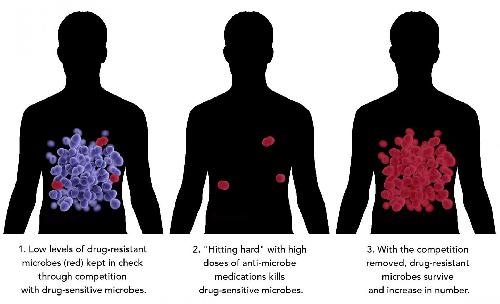A new model shows that the standard practice of treating infections with the highest tolerable dose of anti-microbe medications may not be best for preventing the evolution of drug resistance in all cases. A paper describing the research will be published on Jan. 28, 2016 in the journal PLOS Computational Biology.
"There is nothing in evolutionary theory that says that the dogma of hitting infections hard with high doses of medication should be the best rule of thumb to prevent drug resistance," said Andrew Read, Evan Pugh Professor of Biology and Entomology and Eberly Professor in Biotechnology at Penn State University. "Our analysis demonstrates that although the traditional 'hit hard' approach often works, in some cases it also can be the very worst thing to do."
Read, and colleague Troy Day, professor of mathematics, statistics, and biology at Queen's University in Ontario, Canada, developed a very general mathematical model that quantifies the two main evolutionary forces at work in the evolution of drug resistance in disease-causing microbes. The first evolutionary force they considered is how often drug resistance arises in the microbes through genetic mutation. The second force is the ability of microbes carrying those mutations to survive and increase in number.
 This image illustrates concepts in the press release titled "What is the optimal dose of medication to prevent the evolution of drug resistance" concerning the PLoS Comp Bio paper by Troy Day and Andrew F. Read titled "Does High-Dose Antimicrobial Chemotherapy Prevent the Evolution of Resistance?" Credit: Centers for Disease Control and Prevention and Penn State University
This image illustrates concepts in the press release titled "What is the optimal dose of medication to prevent the evolution of drug resistance" concerning the PLoS Comp Bio paper by Troy Day and Andrew F. Read titled "Does High-Dose Antimicrobial Chemotherapy Prevent the Evolution of Resistance?" Credit: Centers for Disease Control and Prevention and Penn State University
High doses of medications are effective at combatting the first of these evolutionary processes. "There are infections -- HIV is the classic case -- where if you can kill everything by hitting it hard with a cocktail of medications, you should do it," said Read. "Killing all of the infecting microbes obviously stops any further evolution of drug resistance, but we can't do this in every case."
If a small number of microbes already are resistant to treatment, or if drug resistance arises by chance, high doses of medication may allow resistant microbes to survive and spread by the very act of killing off drug-sensitive microbes. "One of the main reasons drug-resistant microbes are rare is that they are in direct competition for resources with their drug-sensitive neighbors," said Read. "High doses of medication can quickly eliminate this competition for resources, allowing drug-resistant microbes to thrive."
Day and Read showed that the optimal approach to combatting the evolution of drug resistance will be either to use the highest dose that is safe or to use the lowest dose that is effective. "We're extending that old rule of thumb to say that the best practice will either be the highest dose or the lowest dose of a drug," said Read. "It's going to be one of those two, but you can't just toss a coin. Determining which is the best approach for a given infectious agent will need to be done on a case-by-case basis in clinical trials. By definition, both will make the patient better in the short term, but we don't know ahead of time which course of action will be best for preventing the evolution of resistance, which leads to more problems in the long term. "
source: Penn State